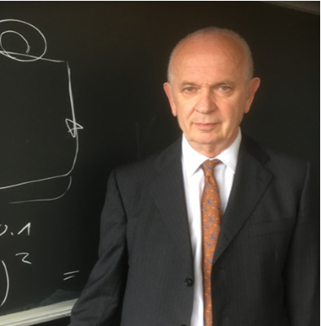
【百家大講堂】第197期⚁:大氣再入條件下的新型光子保護系統
講座題目:大氣再入條件下的新型光子保護系統
報 告 人:Valery Shklover
時 間🙋🏻♂️🧔🏿♂️:2019年5月22日 上午8:30-10:30
地 點:5號教學樓502-1
主辦單位:意昂平台🎈、材料學院
報名方式:登錄意昂官网微信企業號---第二課堂---課程報名中選擇“【百家大講堂】第 期🚶♀️➡️:大氣再入條件下的新型光子保護系統 ”
【主講人簡介】

Valery Shklover,蘇黎世聯邦理工學院教授,ETH-NASA大氣再入保護塗層項目主管🙌🏽,該項目致力於光子保護塗層的設計與模擬,以及太陽能吸收器的設計👩🏿🦳🎭。除此以外,Valery Shklover教授的研究領域覆蓋廣泛,包括熱防護塗層🌽、傳熱學、固態化學、薄膜材料、纖維材料、光子學、超材料🛶、納米結構等、多孔材料等🤷🏻,現已在400多個同行評審出版物上發表學術文章🙇,擁有9項專利🍛。
主講人簡介(英文)
Dr. Valery Shklover has started to work on design and simulation of photonic protective coatings and spectrum splitting for solar photovoltaics. After 2015 Valery Shklover is project coordinator at the Institute of Electromagnetic Fields of the Department of Electrical Engineering and Information Technology of the ETH Zurich, where he is concentrating on the ETH-NASA projects on protection coatings for atmospheric re-entry. He was also supervisor of two PhD works on photonic thermal protective coatings for atmospheric re-entry (his PhD student got ETH medal) and on solar absorbers.
The main scientific interests of Dr. Valery Shklover comprise thermal protective coatings, thermal conductivity modeling, heat transfer, solid-state chemistry, thin films fabrication and properties, fiber materials, photonics, application of correlation function approach to determination materials properties, texture, metamaterials, nanostructures, porous materials, sensors. V. Shklover is author of more than 400 peer-reviewed publications, he owns 9 patents.
【講座信息】
光子熱保護系統(pTPS)可用於在大氣重返大氣層時對航天器進行保護👨🏻🍳,當極高的進入速度導致強烈的電磁輻射時,這種輻射(與對流和催化加熱結合)可導致飛行器表面嚴重過熱。對於月球返回軌道🧑🏽🚒,激波層中電離氣體的電磁輻射可占總熱通量的30-50%;對於木星返回軌道,99%的熱量是輻射性的♠️。pTPS的設計可以調整到特定行星的輻射光譜以及特定的進入條件。pTPS的組成材料應滿足一些嚴格要求,如高溫穩定性、低吸收率🦒、抗氧化性等。需要電介質對比度,允許全向pTPS的設計。本次講座中,將講解反射強電磁輻射的各種光子結構🧘🏼♀️,包括層狀結構、逆蛋白石結構、木樁結構、多孔反射層、編織結構、導模共振反射層等。本次講座中將詳細講解對由玻璃碳(GC)和碳化矽組成的光子結構進行了近紅外輻射光譜的優化🚸。與SiC相比,由於材料吸收🤵🏼,GC結構的反射率限製在約38%👩🏼🔧。然而👨💼🎑,GC可以設計為相對較高的單頻反射~80%👩🏫。光子前體的製備⏲,可將它們可控地作為添加劑整合到目前由NASA多孔浸漬碳燒蝕器使用(形成光子復合物),並且最終測試遵循光子前體的理論研究基礎。此外,講座中將提出考慮製造不精確性對光子結構反射率的影響的方法🫰,即可以通過蒙特卡羅射線追蹤(MCRT)模擬來分析光子添加劑的整合方式,和實現光子復合材料的預期反射率估計。
內容簡介(英文)
The photonic thermal protective systems (pTPS) can be used for protection of space vehicles during atmospheric re-entry, when extremely high entry velocities lead to strong electromagnetic radiation, which (combined with convective and catalytic heating) can cause undesirable heating of vehicle's surface. Electromagnetic radiation from the ionized gas in the shock layer can constitute up to 30-50% of the overall heat flux for lunar return trajectories, albeit for relatively short times. For Jupiter entries 99% of the heating is radiative. The pTPS design can be tuned to the radiative spectra of a specific planet as well as to the specific entry conditions. The constituent pTPS materials should meet a number of the strict requirements to re-entry application, such as high-temperature stability, low absorptivity, oxidation resistance and others. Dielectric contrast is required, permitting the design of omnidirectional pTPS. In this work, various photonic structures for reflecting strong electromagnetic radiation are proposed and optimized, including layered structures, inverse opals, woodpiles, porous reflectors, woven structure, guided mode resonance reflectors. For example, photonic structures composed of glassy carbon (GC) and silicon carbide were optimized for near-infra-red part of radiative spectra. The reflectivity of GC structures, in contrast to SiC, is limited to ~38%, due to material absorption. Nevertheless, GC can be designed for a relatively high single-frequency reflection ~80%. Fabrication of photonic precursors, controlled integration them as additives into currently used by NASA porous impregnated carbon ablators (resulting in formation of photonic composites) and final testing follow the theoretical studies of photonic precursors. The method to take into account the influence of fabrication inaccuracies onto reflectivity of photonic structures is suggested. The way of integration of photonic additives and estimation of expected reflectivity of photonic composites can be analysed by the Monte Carlo Ray Tracing (MCRT) simulations.

